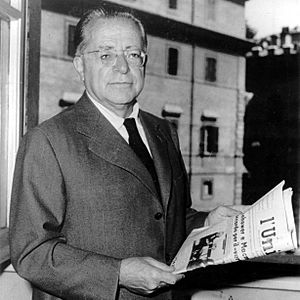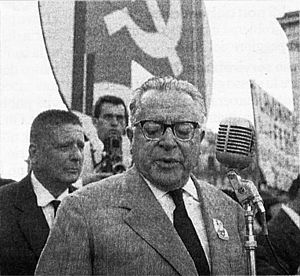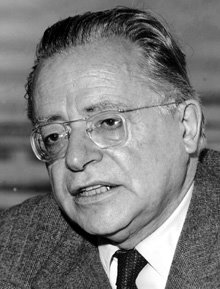Palmiro Togliatti facts for kids
Quick facts for kids
Palmiro Togliatti
|
|
|---|---|
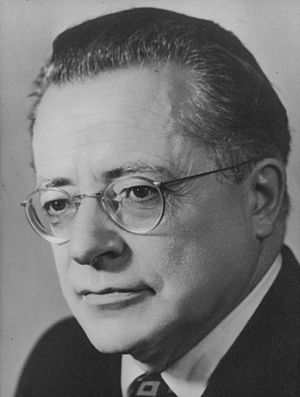 |
|
| General Secretary of the Italian Communist Party |
|
| In office May 1938 – August 1964 |
|
| Preceded by | Ruggero Grieco |
| Succeeded by | Luigi Longo |
| In office November 1926 – January 1934 |
|
| Preceded by | Antonio Gramsci |
| Succeeded by | Ruggero Grieco |
| Minister of Grace and Justice | |
| In office 21 June 1945 – 1 July 1946 |
|
| Prime Minister | Alcide De Gasperi |
| Preceded by | Umberto Tupini |
| Succeeded by | Fausto Gullo |
| Deputy Prime Minister of Italy | |
| In office 12 December 1944 – 21 June 1945 |
|
| Prime Minister | Ivanoe Bonomi |
| Preceded by | Himself (in June 1944) |
| Succeeded by | Manlio Brosio Pietro Nenni |
| In office 24 April 1944 – 18 June 1944 |
|
| Prime Minister | Pietro Badoglio |
| Preceded by | Office established |
| Succeeded by | Himself Giulio Rodinò (in Dec. 1944) |
| Member of the Chamber of Deputies | |
| In office 8 May 1948 – 21 August 1964 |
|
| Constituency | Lazio – XV |
| Personal details | |
| Born | 26 March 1893 Genoa, Kingdom of Italy |
| Died | 21 August 1964 (aged 71) Yalta, Crimean Oblast, Ukrainian SSR, Soviet Union |
| Political party | Italian Socialist Party (1914–1921) Communist Party of Italy (1921–1943) Italian Communist Party (1943–1964) |
| Domestic partners | Rita Montagnana (1924–1948) Nilde Iotti (1948–1964; his death) |
| Residences | Modena, Emilia-Romagna |
| Alma mater | University of Turin |
| Profession |
|
| Signature |  |
Palmiro Michele Nicola Togliatti (Italian: [palˈmiːro toʎˈʎatti]; 26 March 1893 – 21 August 1964) was an important Italian politician. He led Italy's Communist Party from 1927 until he passed away. His supporters called him Il Migliore, which means "The Best." In 1930, he became a citizen of the Soviet Union. Later, a city in that country was named after him: Tolyatti.
Togliatti helped create the Communist Party of Italy (PCI). From 1927 until his death, he was the main leader of the Italian Communist Party. For a few years (1934-1938), he worked for the Comintern, which was an international group of communist parties. After the Comintern ended in 1943, and a new group called Cominform started in 1947, he was offered a top job by Joseph Stalin in 1951. But Togliatti chose to stay as the head of the Italian Communist Party.
From 1944 to 1945, Togliatti was the Deputy Prime Minister of Italy. Then, from 1945 to 1946, he became the Italian Minister of Justice in the governments that formed after Fascism ended in Italy. He was also a member of the group that wrote Italy's new constitution, called the Constituent Assembly of Italy. Togliatti survived an attempt on his life in 1948. He died in 1964 while on holiday in Crimea, near the Black Sea.
Contents
Early Life and Education
Palmiro Togliatti was born in Genoa, Italy, into a middle-class family. His father, Antonio, was an accountant for the government. His mother, Teresa Vitale, was a teacher. Because of his father's job, the family moved often. They moved from Turin to Genoa before Palmiro was born. He was named "Palmiro" because he was born on Palm Sunday. His parents were Roman Catholics. Palmiro had a sister, Maria Cristina, and two brothers, Enrico and Eugenio Giuseppe. Eugenio became a famous mathematician.
In 1908, Togliatti went to high school in Sassari, where he was known as the best student. His father died in 1911, and the family became poor. However, Togliatti received a scholarship, which allowed him to study law at the University of Turin. He graduated in 1917. In 1914, Togliatti started his political journey with the Italian Socialist Party (PSI), before World War I began. He served as a volunteer officer during the war. He was wounded and sent home to recover.
Starting L'Ordine Nuovo
After the war, Togliatti joined a group in Turin that worked on a newspaper called L'Ordine Nuovo. This group was led by Antonio Gramsci. Togliatti also worked as a tutor at this time. Like others who started L'Ordine Nuovo, Togliatti admired the Russian Revolution. He strongly believed that Italy should create its own "soviets," which were councils of workers. He thought that existing factory councils could become strong enough to lead a communist takeover.
The newspaper first focused on cultural topics. But in June 1919, Gramsci and Togliatti changed its focus to be more revolutionary. By the end of that year, the newspaper sold 6,000 copies. Its reputation grew when it supported a general strike in April 1920. The Socialist Party and the main labor union did not support this strike. On January 1, 1921, the newspaper started being published every day.
Forming the Communist Party of Italy
Togliatti was part of the Communist group within the Italian Socialist Party. This group was also part of the Communist International, known as the Comintern. On January 21, 1921, the Socialist Party split during its 17th Congress in Livorno. Togliatti was one of the people who then founded the Communist Party of Italy. This new party was formed by the L'Ordine Nuovo group, led by Gramsci, and another group led by Angelo Tasca.
In 1923, some members of the party were arrested. They were put on trial for "conspiracy against the State." This allowed the Comintern to weaken the party's left wing. Control then went to a smaller group that supported Moscow. In 1924 and 1925, the Comintern started a campaign called "Bolshevisation." This meant that every communist party had to follow Moscow's rules and orders.
Life Under Fascism
In October 1922, Benito Mussolini, the leader of the National Fascist Party, used a general strike to demand political power. If the government didn't agree, he threatened a takeover. A small group of Fascists then began a long walk to Rome, known as the March on Rome. They claimed they would bring back law and order. Mussolini himself joined the march only at the end.
The Fascists demanded that Prime Minister Luigi Facta resign and that Mussolini be named Prime Minister. Even though the Italian Army was much stronger than the Fascist groups, King Victor Emmanuel III faced a political crisis. The King had to choose between Mussolini's Fascists and the anti-monarchy Italian Socialist Party. He chose the Fascists and made Mussolini the new Prime Minister. At first, Togliatti did not see the new fascist government as fully dictatorial. He believed that the fascist government, which he saw as a dictatorship of the wealthy class, would not get rid of traditional democratic ideas.
In August 1923, Mussolini passed a new election law called the Acerbo Law. This law gave two-thirds of the seats in Parliament to the party that got more than 25% of the votes. Togliatti wrote that fascism gained power by breaking up workers' groups and preventing them from uniting. In the 1924 Italian general election, Mussolini's group used threats to win a huge victory. They gained a two-thirds majority. The Communist Party, however, only got 3.74% of the votes and 19 seats. In 1926, the Italian Fascist government banned the party. Amedeo Bordiga and Gramsci were arrested and sent to prison. Togliatti was one of the few leaders not arrested because he was at a meeting of the Comintern in Moscow.
Years in Exile
In 1927, Togliatti was chosen as the General Secretary of the party, taking Gramsci's place. While in exile during the late 1920s and 1930s, he organized secret meetings for the Italian Communist Party in Lyon (1926) and Cologne (1931). In 1935, using the fake name Ercole Ercoli, he became a member of the Comintern's leadership. In 1939, he was arrested in France. After being released, he moved to the Soviet Union. He stayed there during World War II, broadcasting radio messages to Italy. In these messages, he urged Italians to resist Nazi Germany and the Italian Social Republic.
In August 1936, the Comintern published a statement written by Togliatti. It was called "For the Salvation of Italy and the Reconciliation of the Italian People." This statement was aimed at "the blackshirt brothers" (Fascists). It asked Communists and Fascists to unite. It said: "We Communists have adopted the Fascist program of 1919, which is a program of peace, freedom, and protecting workers' interests. ... The Fascist program of 1919 has not been carried out! Let's fight together to make this program happen." In March 1941, Togliatti told the Comintern that Italian Fascism was strong not just because of violence. He said: "This dictatorship has done something – not just through violence. It has done something even for the workers and young people. We cannot deny that the introduction of social security is a fact."
Leading the Italian Communist Party
The "Salerno Turn" and an Attack
In 1944, Togliatti returned to Italy from Moscow. He led his PCI and other political groups in what was called the Svolta di Salerno, or the "Salerno Turn." This was an agreement between anti-fascist parties, the monarchy, and Prime Minister Pietro Badoglio. They agreed to form a government of national unity and to delay decisions about Italy's future government system. Togliatti also started a political magazine called Rinascita after he came back to Italy in 1944. He edited it until he died. The PCI promised to support democracy and to stop using armed struggle to achieve Socialism. This change moved the party more to the right, which was different from what many members wanted. It also meant that members of the Italian resistance movement who were organized by the PCI (the Garibaldi Brigades) had to give up their weapons. Togliatti served as Deputy Prime Minister from December 1944 and then as Justice Minister from June 1945.
After being a minister without a specific department in the Pietro Badoglio government, he became vice-premier under Alcide De Gasperi in 1945. Against the main view in his own party, he voted to include the Lateran Pacts in the Italian Constitution. In the 1946 Italian general election, which happened at the same time as the vote on the new constitution, the PCI got 19% of the votes. They won 104 seats in the new Constituent Assembly.
Communist ministers were removed from the government during the May 1947 crisis. In the same month, Maurice Thorez, the head of the French Communist Party, also had to leave the French government. Like in Italy, the French Communist Party was very strong.
In 1948, Togliatti led the PCI in the first democratic election after World War II. His party lost to the Christian Democrat party. This election was very tense, and the United States played a big part because they saw Togliatti as an enemy during the Cold War. The left-wing parties, allied in the Popular Democratic Front, got 31% of the votes.
On July 14, 1948, Togliatti was shot three times by Antonio Pallante, a fascist student. He was seriously wounded, and his life was in danger for several days. News about his condition was uncertain, which caused a major political crisis in Italy. This included a general strike called by the Italian General Confederation of Labour.
The 1950s and 1960s
Under Togliatti's leadership, the PCI became the second largest party in Italy. It was also the largest non-ruling communist party in Europe. Even though the party was always in opposition at the national level during Togliatti's life, it managed many cities and towns. It also had a lot of power locally and regionally in some areas.
In 1953, he fought against a law called the "cheat or swindle law." This election law was passed by the Christian Democrat-led government. It aimed to use a "first past the post" system to increase the power of the center-right. In the end, the law did not help the government in the elections that year. Togliatti's PCI won 22.6% of the vote. The law was removed in November 1953.
Even though he had a close relationship with the Soviet Union, Togliatti's leadership was not harmed after the Hungarian Revolution of 1956. This event caused big problems for left-wing parties in most other countries. Togliatti developed a theory called "polycentrism." This idea meant that communist parties in different countries could have unity while also having their own differences.
The "Italian Way to Socialism"
After the Khrushchev Thaw in the Soviet Union, Togliatti was inspired by new reforms. He launched the party program called the "Italian way to Socialism." He stated: "We are democrats because we are not only anti-fascists, but also socialists and communists. There is no conflict between democracy and socialism."
This new policy from Togliatti was against using any revolutionary methods to gain power. Instead, it aimed to combine political action with expanding social and labor union struggles. During this time, the PCI removed members who were against this new, more reform-focused approach. In the 1958 Italian general election, the number of Communist votes continued to grow. In the 1963 Italian general election, the PCI got 25.2% of the votes. However, it still did not win the most votes.
Death and Lasting Impact
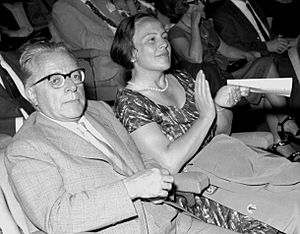
Togliatti died from a brain bleed while on vacation with his partner Nilde Iotti in Yalta, which was then in the Soviet Union. Some of his colleagues believed Togliatti was traveling to the Soviet Union to support Leonid Brezhnev in becoming the new leader of the Communist Party of the Soviet Union, replacing Nikita Khrushchev. His favorite student, Enrico Berlinguer, later became the National Secretary of the PCI. However, Berlinguer's time in office saw the party move away from some of Togliatti's main ideas.
The Russian city of Stavropol-on-Volga was renamed Tolyatti in his honor in 1964, after his death. Togliatti had been important in setting up the AutoVAZ (Lada) car factory there, working with Fiat. A main town square in the Croatian city of Rijeka was also named after Togliatti when Croatia was part of SFR Yugoslavia. It was later renamed Jadranski trg (Adriatic Plaza) in 1994.
Some historians, like Agarossi and Zaslavsky (2011), argue that Togliatti and other PCI leaders largely followed Stalin's orders. They believe Togliatti worked hard to promote Soviet interests. They suggest Togliatti was a strong supporter of Stalin, even after Stalin died in 1953 and the Soviet Union changed many of his policies. They also claim that Stalin told Togliatti to play a moderate role in Italian politics. This was because Stalin felt it was not the right time for a direct conflict with capitalism. These historians used Togliatti's own papers and detailed reports from the Soviet ambassador in Rome to support their arguments. They also state that Stalin made the PCI reject the Marshall Plan, even though it meant losing support from Italian voters who wanted American aid.
Images for kids
See also
 In Spanish: Palmiro Togliatti para niños
In Spanish: Palmiro Togliatti para niños



